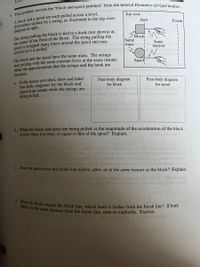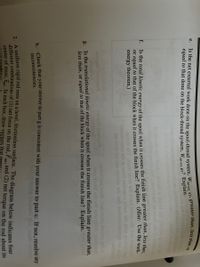
College Physics
11th Edition
ISBN: 9781305952300
Author: Raymond A. Serway, Chris Vuille
Publisher: Cengage Learning
expand_more
expand_more
format_list_bulleted
Concept explainers
Question

Transcribed Image Text:d. When the block crosses the finish line, which hand is farther from the finish line? If both
hands are the same distance from the finish line, state so explicitly. Explain.
Top view
A block and a spool are each pulled across a level,
Start
Finish
diagram at right.
The string pulling the block is tied to a hook (not shown) at
the center of the front of the block. The string pulling the
spool is wrapped many times around the spool and may
unwind as it is pulled.
The block and the spool have the same mass. The strings
start pulling with the same constant force at the same instant.
Make the approximation that the strings and the hook are
Blockj
Same
Same
tension
mass
Spool!
massless.
a. In the spaces provided, draw and label
free-body diagrams for the block and
spool at an instant while the strings are
being pulled.
Free-body diagram
for block
Free-body diagram
for spool
b. While the block and spool are being pulled, is the magnitude of the acceleration of the block
greater than, less than, or equal to that of the spool? Explain.
ns sol to idmos.
C. Does the spool cross the finish line before, after, or at the same instant as the block? Explain.

Transcribed Image Text:equal to that done on the block-thread system, W
BT? Explain.
net ext,
odi nil
30 0on
Is the total kinetic energy of the spool when it crosses the finish line greater than, less than.
or equal to that of the block when it crosses the finish line? Explain. (Hint: Use the work-
energy theorem.)
f.
ad 1erda nobernixounge od sdaM
bne web,bobivonq oo of
bos Abold on 101 amanaib Yood-o
g. Is the translational kinetic energy of the spool when it crosses the finish line greater than,
less than, or equal to that of the block when it crosses the finish line? Explain.
e Check that your answer to part g is consistent with your answer to part c. If not, resolve any
inconsistencies.
A uniform rigid rod rests on a level, frictionless surface. The diagram below indicates four
cferent combinations of (1) net force on the rod, Fnet, and (2) net torque on the rod about its
center of mass, Tret In each box, draw vectors that
Expert Solution
This question has been solved!
Explore an expertly crafted, step-by-step solution for a thorough understanding of key concepts.
This is a popular solution
Trending nowThis is a popular solution!
Step by stepSolved in 4 steps with 2 images

Knowledge Booster
Learn more about
Need a deep-dive on the concept behind this application? Look no further. Learn more about this topic, physics and related others by exploring similar questions and additional content below.Similar questions
- plese show all your work include all diagrams fbd and coordinate systemarrow_forwardA block of mass m is resting on an incline as shown. The incline makes angle with the horizontal. The acceleration due to gravity is g. Diagram a Which force diagram correctly represents the forces applied to the block? Diagram b Diagram c Diagram d Diagram e a) Press F11 to exit full screen b) at rest d) In this situation, we can be certain that the magnitude of the frictional force on the block has value Calculatorarrow_forwardPlease answer both parts to this physics problemarrow_forward
- need help making a graph with my dataarrow_forwardi need help creating a graph using excel or simular for my data in the attached photo. Thanksarrow_forwardThe 3.0-m-long, 06 kg rigid beam in (Figure 1) is supported at each end. A 86 kg student stands 2.0 m from support 1. Part A How much upward force does the support 1 exert on the beam? Express your answer to two significant figures and include the appropriate units. > View Available Hint(s) HA F = Value Units Submit Part B How much upward force does the support 2 exert on the beam? Express your answer to two significant figures and include the appropriate units. > View Available Hint(s) HA ? F2 = Value Units Submit Provide Feedback Figure 2.0 m 3.0 m Support 1 Support 2arrow_forward
- A person pushes a box along the ground. The box has the force diagram shown below. Examine the force diagram to answer the following questions: a. Is the box in equilibrium? If so explain how you can tell. If not, explain why not. b. If the person wants the box to move at constant velocity, should they adjust their pushing on the block? If so, explain how they should change their push. If not, explain why they should change nothing about their pusharrow_forwardPls help ASAP. Pls show all work and calculations. Pls refer the first picture for the diagram and the second picture to answer all of the questions.arrow_forward1. For each free body diagram, find the missing information. You don't need to show your work. Type your answers, with units beside each diagram, where indicated. C. Fn = Fg = En = Ff = 14N Fa = Fa = Fg = m = 5.0kg a = 4.5 m/s2arrow_forward
- Which best explain the function of the pulley in the experiment on the vector addition of forces? * Pulleys were used to know the tension in the string that is the same magnitude with the weight of the hanging mass and have an adjustable direction of the equilibrant. O Pulleys were used to have an adjustable direction in locating the resultant force. Pulleys were used to hang the masses. O Pulleys were used to neglect the friction between the string and the pulley.arrow_forwardPlease show steps, thanks.arrow_forwardPls help ASAP. Pls show all work.arrow_forward
arrow_back_ios
SEE MORE QUESTIONS
arrow_forward_ios
Recommended textbooks for you
 College PhysicsPhysicsISBN:9781305952300Author:Raymond A. Serway, Chris VuillePublisher:Cengage Learning
College PhysicsPhysicsISBN:9781305952300Author:Raymond A. Serway, Chris VuillePublisher:Cengage Learning University Physics (14th Edition)PhysicsISBN:9780133969290Author:Hugh D. Young, Roger A. FreedmanPublisher:PEARSON
University Physics (14th Edition)PhysicsISBN:9780133969290Author:Hugh D. Young, Roger A. FreedmanPublisher:PEARSON Introduction To Quantum MechanicsPhysicsISBN:9781107189638Author:Griffiths, David J., Schroeter, Darrell F.Publisher:Cambridge University Press
Introduction To Quantum MechanicsPhysicsISBN:9781107189638Author:Griffiths, David J., Schroeter, Darrell F.Publisher:Cambridge University Press Physics for Scientists and EngineersPhysicsISBN:9781337553278Author:Raymond A. Serway, John W. JewettPublisher:Cengage Learning
Physics for Scientists and EngineersPhysicsISBN:9781337553278Author:Raymond A. Serway, John W. JewettPublisher:Cengage Learning Lecture- Tutorials for Introductory AstronomyPhysicsISBN:9780321820464Author:Edward E. Prather, Tim P. Slater, Jeff P. Adams, Gina BrissendenPublisher:Addison-Wesley
Lecture- Tutorials for Introductory AstronomyPhysicsISBN:9780321820464Author:Edward E. Prather, Tim P. Slater, Jeff P. Adams, Gina BrissendenPublisher:Addison-Wesley College Physics: A Strategic Approach (4th Editio...PhysicsISBN:9780134609034Author:Randall D. Knight (Professor Emeritus), Brian Jones, Stuart FieldPublisher:PEARSON
College Physics: A Strategic Approach (4th Editio...PhysicsISBN:9780134609034Author:Randall D. Knight (Professor Emeritus), Brian Jones, Stuart FieldPublisher:PEARSON

College Physics
Physics
ISBN:9781305952300
Author:Raymond A. Serway, Chris Vuille
Publisher:Cengage Learning

University Physics (14th Edition)
Physics
ISBN:9780133969290
Author:Hugh D. Young, Roger A. Freedman
Publisher:PEARSON

Introduction To Quantum Mechanics
Physics
ISBN:9781107189638
Author:Griffiths, David J., Schroeter, Darrell F.
Publisher:Cambridge University Press

Physics for Scientists and Engineers
Physics
ISBN:9781337553278
Author:Raymond A. Serway, John W. Jewett
Publisher:Cengage Learning

Lecture- Tutorials for Introductory Astronomy
Physics
ISBN:9780321820464
Author:Edward E. Prather, Tim P. Slater, Jeff P. Adams, Gina Brissenden
Publisher:Addison-Wesley

College Physics: A Strategic Approach (4th Editio...
Physics
ISBN:9780134609034
Author:Randall D. Knight (Professor Emeritus), Brian Jones, Stuart Field
Publisher:PEARSON